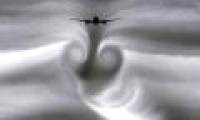
Turbulence that affects planes could become a thing of the past thanks to a new AI system that helps flying vehicles learn to adjust to turbulence in just minutes.

On October 9, the US National Oceanic and Atmospheric Administration (NOAA) shared a clip recording the moment a plane carrying US meteorological experts shook violently while

Scientists reveal the factors behind the turbulence that caused Singapore Airlines (SIA) and Qatar Airways planes to crash.

Surely everyone has experienced the feeling of anxiety, even panic, when the plane suddenly encountered turbulence overhead.

Turbulence is the movement of air created by atmospheric pressure, jet streams, air around mountains, cold or warm weather areas, or thunderstorms.

The higher the flight, the more fuel-efficient the aircraft is, the faster and quieter it flies. But they can't fly into space because of some design limitations.

According to ScienceABC, people who live near the airport are more prone to stress, memory loss and even heart disease.

If you ever fly, surely you have experienced the effects of air turbulence: it is a sudden shake of the plane when taking off and landing, moving in different directions.

Australia has just experienced the hottest winter in the context of long-term warming trends that have contributed to climate change.

Global warming is forcing airplanes to withstand strong gusts of wind, and jolts from air turbulence.
 Turbulence that affects planes could become a thing of the past thanks to a new AI system that helps flying vehicles learn to adjust to turbulence in just minutes.
Turbulence that affects planes could become a thing of the past thanks to a new AI system that helps flying vehicles learn to adjust to turbulence in just minutes. On October 9, the US National Oceanic and Atmospheric Administration (NOAA) shared a clip recording the moment a plane carrying US meteorological experts shook violently while
On October 9, the US National Oceanic and Atmospheric Administration (NOAA) shared a clip recording the moment a plane carrying US meteorological experts shook violently while Scientists reveal the factors behind the turbulence that caused Singapore Airlines (SIA) and Qatar Airways planes to crash.
Scientists reveal the factors behind the turbulence that caused Singapore Airlines (SIA) and Qatar Airways planes to crash. Surely everyone has experienced the feeling of anxiety, even panic, when the plane suddenly encountered turbulence overhead.
Surely everyone has experienced the feeling of anxiety, even panic, when the plane suddenly encountered turbulence overhead. Turbulence is the movement of air created by atmospheric pressure, jet streams, air around mountains, cold or warm weather areas, or thunderstorms.
Turbulence is the movement of air created by atmospheric pressure, jet streams, air around mountains, cold or warm weather areas, or thunderstorms. The higher the flight, the more fuel-efficient the aircraft is, the faster and quieter it flies. But they can't fly into space because of some design limitations.
The higher the flight, the more fuel-efficient the aircraft is, the faster and quieter it flies. But they can't fly into space because of some design limitations. According to ScienceABC, people who live near the airport are more prone to stress, memory loss and even heart disease.
According to ScienceABC, people who live near the airport are more prone to stress, memory loss and even heart disease. If you ever fly, surely you have experienced the effects of air turbulence: it is a sudden shake of the plane when taking off and landing, moving in different directions.
If you ever fly, surely you have experienced the effects of air turbulence: it is a sudden shake of the plane when taking off and landing, moving in different directions. Australia has just experienced the hottest winter in the context of long-term warming trends that have contributed to climate change.
Australia has just experienced the hottest winter in the context of long-term warming trends that have contributed to climate change. Global warming is forcing airplanes to withstand strong gusts of wind, and jolts from air turbulence.
Global warming is forcing airplanes to withstand strong gusts of wind, and jolts from air turbulence.





 Do signals from extraterrestrial civilizations detected by Sky Eye really exist?
Do signals from extraterrestrial civilizations detected by Sky Eye really exist? 'City without air conditioning' in China: People don't know what heat is!
'City without air conditioning' in China: People don't know what heat is! The element of the sun god is giving scientists a headache
The element of the sun god is giving scientists a headache Unique Village: Roofs Become Roads for Residents!
Unique Village: Roofs Become Roads for Residents! Top 7 strange psychological effects of the brain that we all have without knowing
Top 7 strange psychological effects of the brain that we all have without knowing Which is the most terrifying bedroom elixir in Chinese history?
Which is the most terrifying bedroom elixir in Chinese history? Earth's core may start rotating in reverse
Earth's core may start rotating in reverse A day in Japan can be up to 30 hours long, does this country live in a different 'timeline'?
A day in Japan can be up to 30 hours long, does this country live in a different 'timeline'?